NEW CAVES TO EXPLORE (Part three of three)by Harold Stephens
Correspondent for Thai Airways International
My first experience with Thai caves came many years ago when I sailed by yacht from Singapore through the Strait of Malacca to Phuket. We found islands galore, many with caves, including the Viking Cave that I mentioned. The Viking is well known; others are not. At uninhabited Koh Rok Nai we discovered a beach cave with huge phallic carvings placed there by fishermen. The intent wasn't pornographic; it was superstition. Wives of fisherman who worshiped at the caves would become fertile and bear healthy offspring.
The scenery in some of these caves was so appropriate to pirate hideaways one almost expected to find treasure chests and skull and crossbones. That pirates once ruled the Straits is well documented, and we know they found their refuges in caves. And did not pirates bury treasures in caves?
Pirates came with the lucrative trade that began thousands of years ago, and Phuket was the hub. Unearthings in Phuket and in neighbouring Phang-nga have produced Greek and Roman earthenware, golden Arabic coins, and colourful Chinese pottery. There's no question, this idyllic isle and the surrounding seacoast was an ancient port and trading centre.
Marauding pirates cruised the Andaman Sea and the Strait of Malacca down to Singapore, and they found their security in caves and the highly uncertain Trade Winds.
The caves in other parts of Thailand played a much different role than the pirate caves of the south. Their importance is their history, not only the history of Thailand but of all mankind.
When the editors of Sawasdee asked me to do a rundown of the caves of Thailand, I teamed up with photographer Don Bianco, rented an Avis car and together we headed first down to Krabi in the south, then covered the southeast and gradually worked out way to the north. After weeks and 5,000 miles we came to realise that it would be impossible in one's life time to get to know all the caves of Thailand. In fact, it's likely that all of them will ever be known. Man had learned to use caves for shelter and he has built into them elaborate monuments to his gods, but he also developed the knack of losing them. Even their memory becomes lost to man.
Among the countless caves in Thailand, only but a fraction have been explored. New caves are being discovered almost every day. Only a week before we began our explorations, a new cave in Ban Nainang Khao Kram had been discovered following a survey trip by Krabi regional tourist officers, Laddawan Chuaychat and Pisut Phumphamorn.
The cave, they claim, is about 70 metres wide and 20 metres high at its gateway. Inside the cave is a 25-metre long beach with a canal that runs through the cave. The officers believe it may be possible to drive a long-tail boat through the cave to the other side of the hill.
How can a cave become lost? Landslides, violent storms, earth-quakes, volcanic upheavals, and by the efforts of man himself. It's a known fact that caves for some reason or other are sealed by those who want to keep them secret, as the Japanese had done to many caves in Southeast Asia after their defeat in World War 11?
Cave exploring in Southeast Asia is a relatively new sport, if we can call it a sport. Even the name can be misleading. Americans call cave exploring "spelunking." The British say it's "speleology," and they are correct if we use the Oxford English dictionary. On the other hand, Webster's defines a spelunker as one who explores or studies caves. Whatever the name, both are the same.
Spelunking, however, is gradually making its way in Asia. The Malayan Nature Society has a branch called Selangor Branch Caving Group that has been active since February 1983. Shaharin Yussof, one of the group's spokesman, claims that up until a few years ago the group had visited 69 caves in the Malay Peninsula right up to Thai border and surveyed over twenty of them.
The difficulty of cave exploring is finding out what caves have been explored and which have not. Nevertheless, there is beyond any doubt, the caves and underground caverns of Thailand and the Malay Peninsula are the most challenging and interesting in the world. These caves hold many of mankind's most baffling secrets.
For the serious-minded speleologist, the caves of Thailand can offer adventure unchallenged, but only well equipped parties with experience can explore these caves properly and safely. Caves that are marked and listed on tourism maps need not be less interesting than unexplored ones. They can be the beginning.
Although there is no complete guide to the caves of Thailand, many general guide books (Insight Guides' Thailand and Lonely Planet's Thailand) list important caves that can be easily visited. Another good source of cave locations are road maps found in book stores and those provided by car rental agencies. Our AVIS map proved invaluable.
But even the best map will not have all the caves listed. That would be impossible. Also, caves shown on tourists maps doesn't mean they are overrun with tourists. On the contrary, we came upon some that hadn't been visited in months. The paths leading to them were overgrown and difficult to find. Other were impossible to find. And also confusing is that caves may have several names.
Occasionally Thais will uncover a cave, put up a sign for motorists to see, and then offer guide service to visitors who want to see them. These caves are not listed in any guide book or on any road map.
And caves in Thailand don't necessarily mean they are underground caverns. Many exciting caves are found up high in the limestone outcroppings, many hundreds of feet above ground. To get through these caves one must crawl and squeeze. I explored some where I suddenly came upon an exposed face of an outside cliff. The view was always superb.
A number of the remarkable caves can be found along Route 4 in the south which runs through Phang-nga town to the small provincial seaport of Krabi. We closely followed our map, got lost more often than we cared to count, and made discoveries that weren't on the map.
One of the more popular caves near Phang-Nga is Tham Russi or "Hermit Cave." It lies on the left 2 km before the Customs House turnoff. A stalagmite in the shape of a hermit marks the entrance. Many believe therussi has power to cure the sick and predict winning lottery numbers.
Unusual labyrinthine grottoes weave through Tham Russi where visitors can stroll over bridges crossing pools within the cave It's well lighted with neons and it even has toilet facilities.
Continuing 500 meters down the road, passing the governor's office on the left, a sign points out a trail towards Wat Tham Pong Chang, which translates to "Temple-Cave in the Elephant's Stomach." A claustrophobic tunnel to the left of a pool leads into a small shrine adorned with statues of three sacred elephants.
Father south on Route 4 is a splendid cave called Wat Suwannakuha. At the entrance packs of monkeys wait to be feed by visitors, and a sign reads: DO NOT TAKE PHOTOGRAPHS WHEN YOU ARE NOT PROPERLY DRESSED.
It's one of the few caves that has an entrance fee, but the ten baht is well worth it. Wat Suwannakuha has hundreds of Buddhas images, including a large golden reclining Buddha and two large standing Buddhas. The two are also golden. A second set of stairs leads to an upper cave with more images. The cave has mood and provides an ideal setting for the photographer.
Just two kms from Phang-nga, Route 4 reaches a fork where a sign points right to Krabi. Beyond the fork the road rises into a winding pass through giant limestone hills and fertile valleys. At the foot of the pass there's a humble view of a Buddha statue at Wat Kirirong, at the entrance to a hollow under huge cliffs.
South of Wat Kirirong the countryside becomes even more dramatic.
We made the drive at dusk. The horizon on all fronts was outlined with the jagged ridges of endless outcroppings, like contorted dragons of another age. Or were they ancient dinosaurs?
One of the most interesting caves I found in the south was during our return from Krabi. It isn't marked on maps nor is it mentioned in guide books. We saw the simple sign that said THAM PETCH, with an arrow pointing down a side road, and decided to gamble. After driving five kms down a dusty road we arrived at a hut with a rusted tin roof where an old man with a flashlight stood waiting, as though he was expecting us. We parked and he then led us through a dusky rubber plantation to the entrance of a cave, over a path not too well trodden. A statue of Buddha stood at the entrance. Nothing too dramatic. Don took a few photos and we were about to leave when the man bid us to follow him. He lead us to another entrance, and to another adventure.
We spent two days at that cave, and in that time we explored only a few hundred metres, yet the old man claimed the cave was more than seven kms deep. At least that was the furthermost anyone had ever gone. The formations were different than other caves we explored. Some chambers appeared to be manmade, with beautifully formed tubs and basins that served as catchments for water, or perhaps they were altars for some strange gods. We wondered if we might discover dens where prehistoric dinosaurs still dwelled.
Also worth visiting in the south, for the adventuresome traveller with more time to spare, are the caves near the provincial towns of Pattani, Yala, and Narathiwat. Here we find the famous Silpa caves and nearby the larger Tham Koo Ha Pimak which contains a 25-meter-high Buddha image, considered a holy pilgrimage site by southern Thais. About 30 km northeast from Khok Kloi, a dirt road leads to Suan Ku where a limestone cave shelters dozens of Buddha images. Light streaming in through an opening gives the cave a mystical aura.
Villagers claim that crocodiles live in underground streams, and that some of the cave walls gleam with real diamonds. Village children will guide those who wish to climb to the top of Khao Wongse.
Tham Khao Cha Ang Oan in Chonburi is a most unusual cave. It's a Buddhist monastery where monks meditate by candle light every afternoon. Although it's not open to tourists, the head monk will show visitors the cave upon request. Unfortunately, he must start a generator for electricity, and in turn disturb the monks at prayer. No one seems to mind, however.
What many consider the most interesting cave in Thailand is Tham Pha Thai along Route1 between Lampang and Ngao. Nineteen kms before Ngao, a left turn leads to a small grove of teak trees, with an information board and map and a nearby refreshment stand. To reach the cave entrance requires a climb up 283 concrete steps, some broken by roots, past the monks' quarters, to the huge arched entrance to the grotto. In front of the entrance stands a white chedi while immediately inside beneath the sunlit edge sits a gilded Buddha. Behind the Buddha rises a colossal stalagmite from a sea of limestone.
The cave is noted for its slithering green snakes The area around Chiang Mai in the north has some spectacular caves. The best known of these is the Chiang Dao Cave about 70 km. north of town. We reached the cave just before dark and found the lights had been turned off, but for a hundred baht the attendant found us a guide, and with a hissing gas lantern he lead us into its depths. We came upon chamber after chamber, with Buddha images crammed everywhere. With only our gas lantern lighting our way, shadows leaped out at us and sent chills up our backs. Nagas guarded the passageways and in the dim light they became alive and seemed to follow us as we passed. Other shadows danced along the walls making grotesque silhouettes. After several hours the attendant came searching for us, thinking we might have gotten lost.
We continued north on the road to Fang, past the Hmong village of Ban Hua Toa, and came to the turnoff leading to Tubtao Caves. At the end of the track is a hut and from it steps lead to the Light Cave on the right and the Dark Cave on the left. The caves are steeped in Buddhist lore and are said to have been created by the cremation fire of an early devotee.
Doi Inthanon National Park west of Chiang Mai is a major tourist attraction but most visitors miss two interesting sites--the Mae Ya waterfall and Borichinda cave. Mae Ya is on a side road that is paved at the start but becomes impassable to cars; thus visitors must walk.
The cave can be reached by hiking up the trail past Mae Klang cascade and the Pak Na falls. From the falls it's more than an hour's hike up a steep trail.
A two-hour drive from Chiang Mai is Mae Hong Son, one of the remotest towns in Thailand. Worth a visit are the nearby Tham Pla (Fish Cave), the larger Tham Lod cave.
Nor should we forget the River Kwai area. The sixty-room River Kwai Village makes a good base for travel and organizes trips to nearby caves. One trip is by boat. On the way to Sai Yok, the river passes the Cave of Tham Kung with some every impressive stalactites and stalagmites.
Cave exploring in Thailand has only begun. Spelunking, or speleology if you wish, has untold possibilities for the adventure traveller. Even finding them can be an adventure.
Harold Stephens
Bangkok
E-mail: ROH Weekly Travel (hstephens_1@yahoo.com)
Note: The article is the personal view of the writer and does not necessarily reflect the view of Thai Airways International Public Company Limited. | 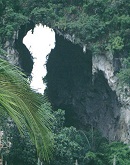
Some cave openings are in cliff sides high up | | 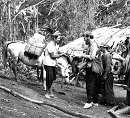
Anthropologist Chet Gorman used mules to reach hidden caves | | 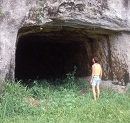
During World War II, Japanese dug 360 miles of caves on Rabaul | | 
Tennessee in America has world’s largest caves | | 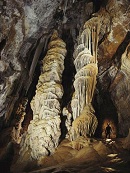
Drop by drop, formations may take centuries | | 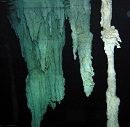
Under ground grotto | | 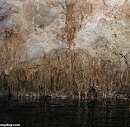
Water caves in Southern Thailand | | 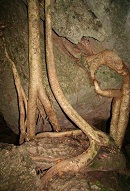
In some caves roots from trees about break though the ceiling | | 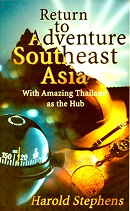
For more about caves read the author’s book Return to Adventure. Copies at www.wolfendenpublishing.com |
|





